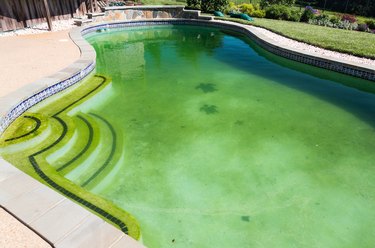
Where there is green pool water, there's algae, especially in hot summer weather. Green algae, unlike its black counterpart, is a true algae; it isn't resistant to chlorine, so you can control it by shocking the pool. If you don't want to spend a lot of money on expensive pool chemicals, you can shock with household bleach. Before you do, it's important to adjust the pH and alkalinity levels to ensure the chlorine will do its job. You can raise pH with household chemicals, but to lower it, it's best to buy some muriatic acid.
Start by Balancing the Chemicals
Video of the Day
Chlorine works best when the pH is between 7.2 and 7.8. It quickly loses is potency when the pH rises above 8.0, and although it can do its job in water with a a pH below 7.0, acidic water is bad for your pool and for swimmers.
Video of the Day
If the pH is below 7.2, you can raise it by adding baking soda -- between 7.2 and 9 pounds per 10,000 gallons. Baking soda will also raise the total alkalinity levels, which should ideally be between 80 and 120 ppm.
If the pH is above 7.8, it's even more important to adjust it, because the effectiveness of chlorine drops sharply with rising pH. You can lower the pH with sodium bisulfate (dry acid) or muriatic acid. Because the latter is a liquid, it works more quickly, but you must add it carefully to avoid damaging the pool decking and your clothes. Here's a handy calculator to help you determine how much you need to add, based on the pool volume and your current pH reading.
Vacuum and Brush the Pool
Once green algae starts growing, it clings to the sides of the pool, the bottom, the ladders and anything else that is underwater. Before you shock the pool, it's important to brush the algae off these surfaces so it will be exposed to the chlorine you add. You should also remove sediment from the bottom of the pool, because chlorine may not kill algae that accumulates in the sediment. Do this with the pool vacuum set to Waste, and be sure to replace the water you remove.
Shock the Pool
When you check the chemical balance of the pool, you may notice that the total chlorine is within acceptable limits, but the concentration of free available chlorine (FAC) probably isn't. Pool shocks are typically oxidizing agents that free chlorine from other compounds it has formed and render it available for sanitizing. If you don't have any shock around the house, you can increase the FAC concentration by adding liquid household bleach.
The usual goal is to raise the FAC concentration to a value between 1 and 3 ppm, but because you're trying to kill algae, it's best to increase the amount of bleach you would normally add and wait for the FAC level to drop before using the pool. You normally need 6 quarts of bleach per 10,000 gallons of water, so to kill algae, you might want to increase this to 8 quarts ( 2 gallons) per 10,000 gallons. If the pool water is very green and cloudy, consider doubling the basic dosage. Just remember to stay out of the water until the chlorine drops to safe levels.
Add the bleach to the pool at night, because it quickly gets degraded by sunlight. Pour it into the water as you walk around the perimeter of the pool, and then circulate the water for six to eight hours. By morning, the algae should be dead -- but instead of being green, the water may be cloudy. This is because an abundance of dead algae particles are suspended in it. At this point, you'll probably want to circulate a clarifier in the water to get rid of the cloudiness.